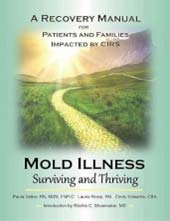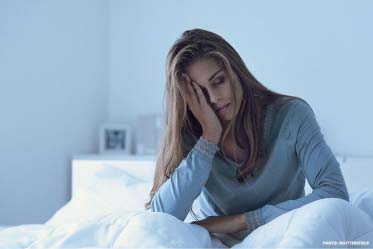Today’s Hot Topic: Biotoxin Associated Illness
Are you dragging through your day, feeling depressed, foggy, inflamed and in pain? Are you quick to anger, unable to focus like never before, and experiencing a strange constellation of symptoms that no doctor can fully explain? If so, your toxic load may be too great for your body to handle, and you may have lost your tolerance to chemicals. But the real root cause in most cases is a Chronic Inflammatory Response from prolonged exposure to a biotoxin.
Understanding Biotoxin and Mold Illness
There are many causes of biotoxins, but 80% come from exposures from indoor environments, especially water damaged buildings. For a long time, we blamed mycotoxins-toxic gases produced from molds, as the primary culprits. But we now know that majority are from actinomycetes, endotoxins and inflammagens from damp buildings microbiomes.
Mold illness is far more prevalent and serious than many clinicians realize. I say that with humility, because in the early years of my practice, I likely missed this diagnosis in many of my patients. You do not know what you do not know and when we close our minds, people stay sick, sad, and in despair.
Years ago, a colleague shared that her inability to lose weight and brain fog as being due to this stealth intruder. She was following the “Surviving Mold” protocols and in my mind, I silently dismissed it as nonsense.
My Story: When the Doctor Becomes the Patient
A decade later I found myself battling the same illness, and like many of my patients, I wasn’t sure if I was going to survive it.
I started to feel like a stranger to myself again.
A quiet sadness crept back in—one I thought I had long since worked through. I was pushing hard just to get through each day. I had gained ten pounds, but for the first time, I didn’t even care. I found myself wondering if my kids would be okay if I were not here.
The exhaustion was overwhelming, the kind that made the idea of tackling the second half of my life feel impossible. I couldn’t see a way forward, and a heavy guilt began to settle in—was I even fit to care for my patients anymore? Did I have anything left to offer?
I clung to the words of Dr. Anthony Silvagni, then the dean of Nova Southeastern University’s College of Osteopathic Medicine, after the birth of my third child: “You need to understand that your 50% is still better than most doctors’ 100%. You need to come back and teach.”
We had just lost our family’s most beloved member, and at first, I told myself it was grief. Then one day, our youngest came in our room saying, “it really smells in here.”
We had a hidden leak from the HVAC system. When the mold assessor inspected the wall, he was shocked that we had been living in those conditions. In our grief, the signs were easy to ignore. I followed many of the integrative medicine guidelines that are preached to heal. But, a year later, I was still sick.
It was not until I extensively studied under Dr. Ritchie Shoemaker and followed his protocol that I began to recover.
The Science Behind CIRS
Dr. Shoemaker coined the condition Chronic Inflammatory Response Syndrome (CIRS) in 1997 after treating groups of patients who were sick from a Pfiesteria, a neurotoxin in estuarine waters. He discovered that in certain genetically susceptible individuals, the immune system is unable to properly eliminate biotoxins. These toxins just recirculate in the body triggering a chronic innate immune system response that the adaptive system fails to shut down.
The condition is genetic: 25% of the population carries specific HLA haplotypes that impair their ability to recognize and clear biotoxins. That’s why most people in a water damaged building will feel fine, while others spiral into chronic illness and start questioning their sanity.
A Multi-Symptom, Multi-System Mystery
There are 37 hallmark symptoms, that involve almost every system. If you have 8 out of 13 symptom clusters and fail a Visual Contrast Study (VCS) test, there is a 98% likelihood you are dealing with CIRS:
- Fatigue
- Weakness, decreased assimilation of new knowledge, aches, headaches, light sensitivity
- Memory, decreased word finding
- Concentration
- Joint pain, morning stiffness, cramps
- Unusual skin sensations, tingling, unusual pain, tremors
- Shortness of breath, sinus congestion
- Cough, excessive thirst, confusion
- Appetite swings, body temperature regulation issues, urinary frequency
- Red eyes, blurred vision, night sweats, mood swings, icepick pains
- Abdominal pain, diarrhea, numbness
- Tearing, disorientation, metallic taste
- Static shocks, vertigo
Testing and Diagnosis: What Actually Works
Air quality tests are inadequate. My own home had such a high biotoxin burden that even air sampling picked it up. But often, it doesn’t. If your space smells musty, actinomycetes are likely present and you are not free and clear of it. Dust testing, such as ERMI or HERTSMI-2 from Envirobiomics, is currently the best method to detect environmental biotoxins, especially actinomycetes and endotoxins. You can also order HLA genetic testing to determine if you’re one of the lucky 25%.
Serum markers that are frequently altered in CIRS include:
- TGF-Beta 1
- C4a
- VEGF
- MMP-9
- MSH
These biomarkers are often abnormal when basic labs indicating inflammation, like CRP and ESR, are normal. I have tested siblings with identical HLAs living in the same environment and found nearly exact serum abnormalities, reconfirming this gene-environment interaction as a root cause of CIRS.
We need to proceed with caution when dealing with some commercially available testing and treatment options. Elevations of urinary mycotoxin and antibodies to mold are found in some healthy individuals, leading to false positives. Antifungal treatments based solely on these tests can alter our mighty mitochondria and delay recovery.
The Path to Recovery
Healing starts with removing exposure. If you remain in a contaminated space, progress is limited, if not impossible. It is important to know that you can carry the toxins with you on your clothes and porous materials if not handled correctly.
The only validated treatment approach is the Shoemaker 12 Step Protocol, which includes:
- Removing exposure
- Binding circulating biotoxins with “anion resin binders” like cholestyramine or Welchol
- Treating MARCoNs (a biofilm-forming staph in the sinuses)
- Normalizing disrupted neuroimmune markers
- Administration of VIP (vasoactive intestinal peptide) once the patient meets recovery thresholds
Some patients may benefit from adjunctive therapies, like peptides, for symptomatic relief, especially if more than one etiology is at play, as in Lyme disease and co-infections. But they need to be instituted at the right time in the process. Treating hormones prematurely can backfire if the root cause is not addressed and can worsen the symptoms. People are different and individualized care is what is most important.
While you wait to get into see a Shoemaker trained physician, you can start removing yourself from the exposure, improving detoxification with fiber and pre-treating with fish oils.
A New Era of Hope
We now have advanced tools like NeurQuant MRIs and transcriptomics, epigenetic tests, to detect neuroinflammatory patterns and even identify triggering organisms. Recent studies have now linked CIRS not only to depression and chronic fatigue, but also to neurodegenerative diseases like Parkinson’s and dementia.
These are exciting times. Thanks to research and pioneers like Dr. Shoemaker, there is now a cure. For those suffering with chronic unexplained illness—there is thankfully hope.
I’m living proof. And now, I get to see my patients not just survive, but thrive.
Wishing you wellness,
Dr. Anjali Noble
P.S. Let me know what you’d like me to cover next!
Recommended Reading

A Recovery Manual for Patients and Families Impacted by CIRS
By Paula Vetter, Laurie Rossi and Cindy Edwards
Foreword by Ritchie C. Shoemaker, MD
This is an excellent resource for anyone struggling with CIRS. “May you hold onto hope knowing healing is possible and you are not alone.”
– Dr. Anjali Noble
References
The Art and Science of CIRS
- Dooley M, McMahon S, A Comprehensive Review of Mold Research Literature from 2011-2018. Internal Medicine Review. Vol 6; Page 1.
- Shoemaker R. Diagnosis of Pfiesteria-human illness syndrome. MMJ 1997. Page 121.
- Shoemaker R. Residential and Recreational Acquisition of Possible Estuary-Associated Syndrome: A New Approach to Successful Diagnosis and Treatment. EHP 2001; 109:971.
- Shoemaker R, Rash J, Simon E. Sick Building Syndrome in Water Damaged Buildings: Generalization of the Chronic Biotoxin-Associated Illness paradigm to Indoor Toxigenic Fungi. 2006 Johanning, ed., Toxicology and Neurological Effects.
- Shoemaker R, House D, Ryan J. Defining the neurotoxin derived illness chronic ciguatera using markers of chronic systemic inflammatory disturbances: A case/control study. NTT 2010; 1:7.
- Shoemaker R, House D, Ryan J. Vasoactive intestinal polypeptide (VIP) corrects chronic inflammatory response syndrome (CIRS) acquired following exposure to water-damaged buildings. Health 2013; 396:401.
- Shoemaker R, House D, Ryan J. Structural brain abnormalities in patients with inflammatory illness acquired following exposure to water-damaged buildings: A volumetric MRI study using NeuroQuant. NTT 2014; 1:9.
- McMahon S, Shoemaker R, Ryan J. Reduction in Forebrain Parenchymal and Cortical Gray Matter Swelling across Treatment Groups in Patients with Inflammatory Illness Acquired Following Exposure to Water-Damaged Buildings. J. Neurosci Clin Res 2016; 1:1.
- Shoemaker R, McMahon S, Ryan J, et al. Intranasal VIP safely restores volume to multiple grey matter nuclei in patients with CIRS. Shoemaker R, McMahon S, et al. Internal Medicine Review 2017; Page 1.
- Ryan, J, Wu Q, Shoemaker R. Transcriptomic signatures in whole blood of patients who acquire a chronic inflammatory response syndrome (CIRS) following an exposure to the marine toxin ciguatoxin. BMC Medical Genomics 2015; 8:15.
- Ryan J, Shoemaker R. RNA-Seq on patients with chronic inflammatory response syndrome (CIRS) treated with vasoactive intestinal peptide (VIP) shows a shift in metabolic state and innate immune functions that coincide with healing. Medical Research Archives, 2017, 4:1.
- McMahon S. An Evaluation of Alternate Means to Diagnose Chronic Inflammatory Response Syndrome and Determine Prevalence.
- Shoemaker R, Lark D. Urinary Mycotoxins: A Review of Contaminated Buildings and Food in Search of a Biomarker Separating Sick Patients from Controls. Internal Medicine Review 2019; Page 1.
- Head, A Sarah, et al, Antifungal drug itraconazole targets VDAC 1 to modulate the AMPK/mTOR signaling axis in endothelial cells. PNAS, December 10, 2015.
- Shoemaker, et al. A Novel Therapeutic Approach to Parkinson’s Disease: Using Transcriptomics to Identify Unique Patterns of Gene Expression including ‘Triple Positives, Toll receptors, and Endotoxin Exposure. The European Society of Medicine, Medical Research Archives, Volume 13 Issue 6, June 30, 2025.

